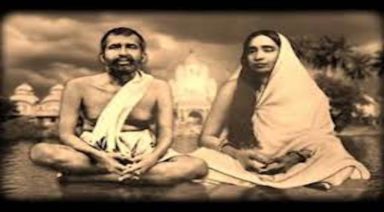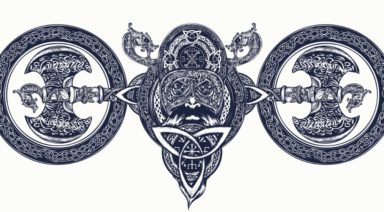Behold the Light of the Goddesses: Norse

An icy north wind sweeps across a battlefield as tense, warring tribes anticipate the beginning of battle. A black cloud approaches, sparking ominous electricity, as thunder warns of impending danger. Thick, dark tendrils fall out of the clouds, revealing women riders in full combat armor on massive steeds. These riders rush to the warriors, who immediately fall upon each other in ferocious battle. The riders are the Valkyries, the daughters of Odin, and theirs is the world of war.
This sets the scene for a mythology that presents its goddesses in a way not common to most religions. The femininity of Norse goddesses is unquestionable, but so is their strength and determination, as well as the ability to fight. Other ancient religions also portrayed goddesses as being involved with warfare, battlefield strategy and hunting. For example, ancient Egypt had Sekhemet and Neith. Greece revered Artemis and Athena as powerful warriors.
In Norse mythology, however, strength, determination and battle abilities weren’t an exception for goddesses; they were the rule.
I’m honored to present a brief look at a few Norse goddesses. Norse myths hold a depth that always excites my imagination. I hope you enjoy them as much as I do.
Frigg: Goddess of Foreknowledge
Frigg was the wife of Odin and the mother of Baldr the Beautiful. Baldr was a solar deity, kind and beloved in every way. His brother, Hodr, was blind and the two were devoted to each other. So deep was Frigg’s love for her son, that she devised a plan to keep him safe forever, impervious to anything that existed in the Universe. She sought and received a vow of compliance from everything, both living and inanimate, never to hurt her son. From the highest mountain peak, to the deepest depths of the seas, everything of the earth and sky gave an unbreakable promise to never injure Baldr, except for one plant. Frigg considered mistletoe to be completely harmless. As parasitic flora, it lives upon the boughs of other trees and as such, mistletoe was neither a plant of the earth, nor a product of the sky and was not bound by the oath taken by every other being, or thing, that existed. Loki, the trickster of Norse mythology, angry and jealous of the attention being put to this project, disguised himself as an old woman and approached Frigg, asking her for details regarding the promises given to her. Frigg told the old woman how she’d not worried about mistletoe and the wheels of tragedy were set in motion.
To celebrate Baldr’s magical protection, an event was planned in which the gods would take turns hurling stones, throwing spears, shooting arrows and doing whatever else they could to the immortal Baldr. Assault after assault was made by the boisterous deities. Baldr smiled calmly, totally unharmed as every missile simply fell at his feet or had no affect. The gods cheered and celebrated his power of invulnerability. Loki, still in the disguise of the old woman, approached the contest with Baldr’s blind brother, Hodr, whom was thrilled to be able to participate in the celebration. Loki had fashioned a dart of mistletoe, which he placed in Hodr’s hand and helped him aim. Everyone watching cheered Hodr. He threw the dart as hard as he could, expecting to hear the usual cheers, but to everyone’s horror, the dart went through Baldr’s body and he instantly fell dead. Loki was eventually discovered and punished for his treachery, but the real power of this myth is in the reality it reflects.
Although this myth is a fascinating take on the movement of the Sun upon the ecliptic during the cycle of the year, it also offers powerful commentary regarding a mother’s attempt to provide protection for her children and the inevitable truth, that no matter how careful one may be, the unexpected is always a part of life. Another interesting pattern in this myth is the disguising of Loki as an old woman. This motif is repeated in another Norse myth in which Thor engages in a series of competitions while in a magician’s realm. Thor is challenged to wrestle an elderly woman, toothless and decrepit in appearance. As Thor begins the bout, he’s amazed to find the woman to be remarkably strong, with a grip like iron. Laughing, she easily drops Thor to his knees and the contest is mercifully ended before the god is totally defeated. Thor is understandably humiliated, but eventually discovers that the woman is much more than she seems to be and is, in fact, Old Age itself. Not even the God of Thunder could overcome the power of Time. This tale of an old lady being more than she seems is repeated in tales like Hansel and Gretel and other stories that feature Wicked Witches disguised as helpless old ladies. The message is clear. Never underestimate anyone, for they may not be as they seem. The arrogance of assumptions based on the way people look is dangerous, to say the least.
Frigg is often considered to be a goddess with foreknowledge, seeing deeply into the future and able to discern the paths and destinies of both men and gods alike, not unlike the Norns (knowers of all destiny). It’s significant that with this ability, she was still unable to prevent the death of her son, Baldr. There’s a deep message behind this story, one that bears mulling over.
Freyja: Embodiment of Passion and Joy
Freya is often called the Norse Venus, or Goddess of Love. This description is a vast oversimplification. Freyja could be seen as the embodiment of passion, celebrations and joy. She was the happiness of a successful harvest and the fertility that brought new animal life to our planet. She was filled with desire and inspired it in others. She brought the joy of life into the hearts of even the most cynical. Her beauty was matched only by her strength and her skills in the magical arts, making her a deity to reckon with. In some cultures, Freyja would have been considered a sorceress. She was definitely a Shaman. Her ability to walk between worlds and affect the outcome of the future, made her a deity to be respected. Freyja wasn’t Aesir, like Frigg. The Aesir dealt with warfare and the affairs of the heavens. She was Vanir, the rulers of the Earth and fertility. As such, her realm focused on the more tangible aspects of life, including love and need.
A popular story about Freya has to do with her immense beauty. A Jotun (enemy of Aesir and Vanir) stole Thor’s hammer and demanded that Freya be delivered as his bride, or never see the hammer again. This problem was solved by dressing up a furious Thor to look somewhat like Freya and delivering him into the thief’s kingdom. I’ll bet you can figure out how the story turned out.
Freya ruled over an afterlife known as Folkvangr, meaning “warrior’s field” This was where she delivered half of the warriors slain in battle, the other half destined to spend eternity in Valhalla. No one seems certain as to what the actual criteria was that decided the destination of the souls of the fallen. I believe that some men were suited mainly for battle, having been born warriors, while others were called into war from other walks of life. This was a good and fair division, giving each of the fallen their best possible eternity. There’s benevolence in that idea, one that speaks to the respect of a culture for those who sacrifice their lives in war.
Idunn: Keeper of Eternal Life
Idunn was in charge of the Golden Apples that bestowed eternal life to the Gods. As was the case with Freya, she was abducted, this time through the treachery of Loki. To make a long story short, Idunn was abducted by a giant and then retrieved by Loki, under duress.
The main point of interest with Idunn is her affiliation with the fruit of eternity. She’s reminiscent of the Hesperides, the keepers of the Greek Golden Apples. The Priestess in Tarot is often shown with seed bearing fruits and flowers. The reality is that such fruits are the immortality of the species of flora involved, just as woman, the real goddesses, bear within them the immortality of mankind. This may bring to mind the fruit eaten by Eve in The Garden. I’ll leave it to the reader to ponder the importance of this train of thought.
Hel: Powerful and Intimidating
One of the most interesting of the Norse goddesses, Hel, was the daughter of Loki and the ruler of Niflheim, the land of the dead for those hadn’t died heroically. Half alive and half corpse, she was powerful and intimidating. At one time, “going to Hel” meant to die without heroic honor.
The Valkyries: Choosers of the Slain
Of all the female entities in Norse mythology, perhaps none are as indicative of powerful feminine energy as the Valkyries. The word Valkyrie means “chooser of the slain.”” These women were daughters of Odin, chief of the Aesir. They moved into the dreams of warriors, giving them visions of blood and carnage. These were warnings of unavoidable combat, omens of dark outcomes. Battles only began when the Valkyries rode to the battlefield. The Valkyries chose who won and who lost, usually at the direction of their father. Disobeying Odin’s direction did happen, with grave consequences. After a battle ended, the Valkyries transported those chosen to reside in Valhalla. There, the Valkyries waited upon the resurrected warriors in an eternity of feasting, drinking, fighting, dying and being resurrected. I can’t think of another mythological version of the afterlife like this one.
Richard Wagner’s Classic operatic series, Der Ring des Nibelungen, tells the story of Siegfried, an ancient hero of the Norse and Brunnhilde, the Valkyrie whom falls in love with him. Brunnhilde defies her father, Odin, by trying to save Siegfried’s father’s life. In a nutshell, she’s punished with mortality, betrays her beloved Siegfried, gets him killed and eventually throws herself on his funeral pyre, singing as she goes. It may not end happily, but wow what an ending. If it had be me, I’d have had her last note be Soprano C” thus ending the opera on a high note.
The Norse Gods have become fashionable again, due in part to the cinema, but the big screen renditions of these deities bear little resemblance to their bigger than life counterparts.
There’s a grandeur and majesty to the gods of the Norse, a sense of heroic dynamism that can fill we mere mortals with awe and never fails to entertain and excite the imagination.
I wish you all peace and love.
Ramakrishna and Sarada Devi: Spiritual Ecstasy, Love and Vedanta

Sri Ramakrishna and Sarada Devi lived together in the 1800s as married awakened masters, although Sarada Devi rarely used language that portrayed herself in this way. Throughout her life, she was a devoted wife, disciple, and chaste nun.
After immersing himself in the traditions, teachings, and practices of many religions, Ramakrishna Paramahansa grew to worship the Divine Mother. Soon into their union, Ramakrishna would regard Sri Sarada Devi as an incarnation of The Divine Mother. He regularly addressed her as “Holy Mother.”
Both of these Indian guru-mystics were deeply committed saints in service to humanity. It’s quite rare when two enlightened souls find each other so early in their lives and then co-create a unified, congruent mission.
Upon moving into their home together, Ramakrishna asked Ma Sarada Devi if she came to distract him from his Godly life and pull him into the world of Maya. Sarada Devi responded, “No, I am here to help you realize your Chosen Ideal.”
“One must have devotion towards one’s own guru. Whatever may be the nature of the guru, the disciple gets salvation by dint of his unflinching devotion towards his guru.”
— Sarada Devi







